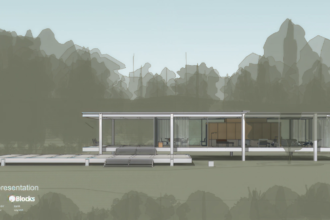Picture your city for a moment. The streets you walk every day, the buildings that take your breath away, and the parks where you find moments of peace.
You might not realize it, but all of this results of the throughout and precise work of architecture and urbanism.
Many people mistakenly believe that architecture and urbanism are just university courses, but the concept carries far greater significance.
So, don’t think of these fields as merely designing large buildings or organizing streets.
Architecture and urbanism shape every aspect of our daily lives, influencing how we interact with spaces and the built environment.
In this article, we’ll break down the concept of architecture and urbanism. Let’s get started? Enjoy your reading!
What is Architecture?

To fully grasp the concept of architecture and urbanism, we must first define each term.
Architecture is both an art and a science, focused on shaping physical space through the design of buildings and structures.
That’s why it encompasses interior and exterior design, considering functionality, aesthetics, comfort, and sustainability.
In essence, architecture is a multidisciplinary field that balances art and engineering, innovation and tradition, vision and practical constraints.
What is Urbanism?

Urbanism, on the other hand, is the study and planning of urban development, in other words , our cities.
While architecture focuses on individual buildings, urbanism deals with organizing and designing entire cities, neighborhoods, and public spaces.
It examines human behavior in urban settings to implement strategies that improve quality of life.
Studies explore the relationship between these two disciplines, emphasizing how architecture is influenced by urban environments and vice versa.
What Does an Architecture and Urbanism Professional Do?
Architects are responsible for designing buildings, houses, commercial establishments, and a variety of other spaces.
Their main goal is to plan and organize both interior and exterior areas, ensuring that each project is both functional and aesthetically pleasing. Their key responsibilities include:
- Supervising, coordinating, and managing the technical aspects of construction projects;
- Conducting research, gathering data, and developing project plans;
- Assessing technical and environmental feasibility;
- Providing technical assistance, consultancy, and advisory services;
- Overseeing construction work and technical services;
- Conducting inspections, evaluations, monitoring, technical reports, and audits;
- Holding technical and managerial positions;
- Engaging in training, teaching, research, and academic outreach;
- Performing testing, standardization, measurement, and quality control;
- Preparing budgets and cost estimates;
- Developing and implementing specialized techniques;
- Executing, supervising, and managing construction projects.
Urban planners or urban designers specialize in managing city growth, infrastructure development, and the overall planning of urban spaces.
What Does an Architecture and Urbanism Degree Cover? 
Starting to see how architecture and urbanism go beyond just academic fields? They shape every aspect of the spaces we live in.
However, it’s important to remember that a formal education is essential for those looking to build a professional career in architecture and urbanism.
An architecture and urbanism degree is a multidisciplinary program that trains students to design, plan, and construct physical spaces.
Typically lasting five years, the Bachelor of Architecture (B.Arch) curriculum blends theoretical and practical coursework, covering topics like art and architecture history, technical drawing, urban planning and so much more!
In the U.S., some universities also offer a Bachelor of Science or Arts in Architecture (B.S./B.A.), a four-year program that provides a strong foundation but usually requires further study through a Master of Architecture (M.Arch) for professional licensure.
Students learn to analyze urban spaces, develop innovative architectural solutions, and manage construction projects.
The goal is to prepare professionals capable of creating cities that are more livable, efficient, and sustainable.
Online Architecture and Urbanism Degrees

Despite some skepticism, online architecture and urbanism degrees are a viable and increasingly popular option, especially for those unable to attend in-person classes.
The main difference lies in the learning format: traditional courses require physical presence, while online programs offer flexible or fully remote education.
One of the main advantages of an online architecture and urbanism degree is the flexibility it offers – students can study anytime, anywhere.
This flexibility allows students to balance their personal, professional, and academic lives, giving them the freedom to structure their schedules as needed.
While some may be skeptical about online degrees, many institutions leverage advanced digital tools and interactive platforms to enhance student learning.
Moreover, most online architecture and urbanism programs offer comprehensive academic and technical support to help students navigate challenges successfully.
How Long Does an Architecture and Urbanism Degree Take?
Unlike many other college programs, architecture degrees typically take longer to complete, usually around ten semesters or five years.
During this time, students go through a rigorous curriculum that blends theory and hands-on practice, covering subjects such as architectural design, technical drawing, and more.
But why does it take so long? This extended period ensures in-depth learning and skill development, preparing future architects to meet the demands of the professional field.
How Much Does an Architect Earn?

An architect’s salary in the United States varies based on factors such as location, experience, project type, and current job market conditions. On average, an architect earns approximately US$ 146.414 per year. For example:
- Entry-level architects typically earn around $75,778 per year.
- Senior or specialized architects can earn upwards of $140,000 to $170,000 annually, especially in high-demand sectors like sustainable design or high-tech buildings.
These figures may fluctuate significantly depending on the region and specific industry demands.
What Are the Main Fields in Architecture and Urbanism?
Architecture and urbanism offer a wide range of career opportunities, spanning from building design to urban planning and historic preservation. Key fields include:
- Structural Architecture: Designing and constructing residential, commercial, and institutional buildings.
- Landscape Architecture: Planning parks, gardens, and public outdoor spaces to enhance environmental and community well-being.
- Interior Architecture: Creating functional, aesthetic, and ergonomically optimized indoor spaces.
- Historic Preservation and Restoration: Conserving and rehabilitating historic buildings and landmarks to maintain cultural heritage.
- Urban Planning: Designing and managing urban spaces while addressing social, economic, and environmental factors.
- Sustainable Architecture: Integrating eco-friendly materials, energy-efficient systems, and green technologies into architectural projects.
Plugin Blocks: The Best Tool for Your Studies!
Thinking about pursuing a degree in architecture and urbanism? Chances are, you’ll come across Autodesk® Revit!
We know that learning a program like this isn’t always easy. But with Plugin Blocks, the process becomes much faster and more efficient.
Plugin Blocks is a powerful BIM tool that streamlines your workflow and make Revit even easier to use.
Instead of spending hours searching for and editing families, you will gain access to over 5,000 parametric families with just a few clicks.
Conclusion
Throughout this article, we’ve seen that architecture and urbanism are more than just academic fields: they are part of our everyday lives.
Architecture is everywhere, from the park where you go to unwind to the apartment you rent for your family.
Truly understanding architecture and urbanism gives us a deeper perspective on the world and how it functions.
In other words, architecture matters not just to professionals but to anyone who interacts with the built environment.
Enjoyed this article? For more content, visit the Blocks blog!
What are you waiting for? Hurry and install Plugin Blocks for free! Visit our website, check out our plans, and get started with our plugin today!













